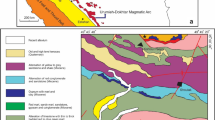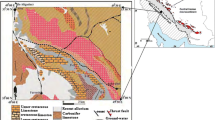Abstract
The Bijgan barite deposit, which is located northeast of Delijan in Markazi Province of Iran, occurs as a small lenticular body at the uppermost part of an Eocene volcano-sedimentary rock unit. The presence of fossiliferous and carbonaceous strata suggests that the host rocks were deposited in a quiet marine sedimentary environment. Barite, calcite, iron oxides and carbonaceous clay materials are found as massive patches as well as thin layers in the deposit. Barite is marked by very low concentrations of Sr (1–2%) and total amounts of rare earth elements (REEs) (6.25–17.39 ppm). Chondrite-normalized REE patterns of barite indicate a fractionation of light REEs (LREEs) from La to Sm, similar to those for barite of different origins from elsewhere. The LaCN/LuCN ratios and chondrite-normalized REE patterns reveal that barite in the Bijgan deposit is enriched in LREE relative to heavy rare earth elements (HREEs). The similarity between the Ce/La ratios in the barite samples and those found in deep-sea barite supports a marine origin for barite. Lanthanum and Gd exhibit positive anomalies, which are common features of marine chemical sediments. Cerium shows a negative anomaly in most samples that was inherited from the negative Ce anomaly of hydrothermal fluid that mixed with seawater at the time of barite precipitation. The δ18O values of barites show a narrow range of 9.1–11.4‰, which is close to or slightly lower than that of contemporaneous seawater at the end of the Eocene. This suggests a contribution of oxygen from seawater in the barite-forming solution. The δ34S values of barites (9.5–15.3‰) are lower than that of contemporaneous seawater, which suggests a contribution of magmatic sulfur to the ore-forming solution. The oxygen and sulfur isotope ratios indicate that submarine hydrothermal vent fluids are a good analog for solutions that precipitated barite, due to similarities in the isotopic composition of the sulfates. The available data including tectonic setting, host rock characteristics, REE geochemistry, and oxygen and sulfur isotopic compositions support a submarine hydrothermal origin for the Bijgan barite deposit. At the seafloor, barite deposition occurred where ascending Ba-bearing hydrothermal fluids encountered seawater. Sulfate was derived from the sulfate-bearing marine waters, and, to a lesser extent, by oxidized H2S, which was derived from magmatic hydrothermal fluids.








Similar content being viewed by others
References
Alavi M (1980) Tectonostratigraphic evolution of Zagrosides of Iran. Geol 8:144–149
Alavi M (1994) Tectonics of Zagros Orogenic belt of Iran, new data and interpretation. Tectonophys 229:211–238
Alexander BW, Bau M, Andersson P, Dulski P (2008) Continentally-derived solutes in shallow Archean seawater: Rare earth element and Nd isotope evidence in iron formation from the 2.9 Ga Pongola Supergroup, South Africa. Geochim Cosmochim Acta 72:378–394
Bao SX, Zhou HY, Peng XT, Ji FW, Yao HQ (2008) Geochemistry of REE and yttrium in hydrothermal fluids from the Endeavour segment, Juan de Fuca Ridge. Geochem J 42:359–370
Bau M, Dulski P (1996) Distribution of yttrium and rare-earth elements in the Penge and Kuruman iron-formations, Transvaal Supergroup, South Africa. Precambrian Res 79:37–55
Bau M, Koschinsky A, Dulski P, Hein JR (1996) Comparison of the partitioning behaviours of yttrium, rare earth elements, and titanium between hydrogenetic marine ferromanganese crusts and seawater. Geochim Cosmochim Acta 60:1709–1725
Bau M, Usui A, Pracejus B, Mita N, Kanai Y, Irber W, Dulski P (1998) Geochemistry of low-temperature water-rock interaction: evidence from natural waters, andesite, and iron-oxyhydroxide precipitates at Nishiki-numa iron-spring, Hokkaido, Japan. Chem Geol 151:293–307
Berberian M, King GCP (1981) Towards a paleogeography and tectonic evolution of Iran. Can J Earth Sci 18:210–265
Berberian F, Muir ID, Pankhurst RJ, Berberian M (1982) Late Cretaceous and early Miocene Andean-type plutonic activity in northern Makran and central Iran. J Geol Soc Lond 139:605–614
Bozkaya G, Gökce A (2004) Trace- and rare-earth elemnt geochemistry of the Karalar (Gaipasa-Antalya) barite-galena deposits, Southern Turkey. Turk J Earth Sci 13:63–75
Chen D, Qing H, Yan X, Li H (2006) Hydrothermal venting and basin evolution (Devonian, South China): Constraints from rare earth element geochemistry of chert. Sediment Geol 183:203–216
Chiba H, Sakai H (1985) Oxygen isotope exchange rate between dissolved sulfate and water at hydrothermal temperatures. Geochim Cosmochim Acta 49:993–1000
Clark SHB, Poole FG, Wang Z (2004) Comparison of some sediment-hosted, stratiform barite deposits in China, the United States, and India. Ore Geol Rev 24:85–101
Davoudzadeh M (1997) Iran. In: Moores EM, Fairbridge RW (eds) Encyclopedia of European and Asian regional geology. Chapman & Hall, London, pp 384–405
de Ronde CEJ, Faure K, Bray CJ, Chappel DA, Wright IC (2003) Hydrothermal fluids associated with seafloor mineralization at two southern Kermadec arc volcanoes, offshore New Zealand. Miner Depos 38:217–233
de Ronde CEJ, Hannington MD, Stoffers P, Wright IC, Ditchburn RG, Reyes AG, Baker ET, Massoth GJ, Lupton JE, Walker SL, Greene RR, Soong CWR, Ishibashi J, Lebon GT, Bray CJ, Resing JA (2005) Evolution of a submarine magmatic-hydrothermal system: Brothers Volcano, Southern Kermadec Arc, New Zealand. Econ Geol 100:1097–1133
Derkachev AN, Bohrmann G, Greinert J, Mozherovskii AV (2000) Authigenic Carbonate and Barite Mineralization in Sediments of the Deryugin Basin (Sea of Okhotsk). Lithol Miner Resour 35:504–519
Ding L, Zhong D (1996) Characteristics of rare earth elements and cerium anomalies in cherts from the Paleo-Tethys in Changning-Menglian belt in western Yunnan, China. Sci China (Ser D) 39:35–45
Douville E, Bienvenu P, Charlou JL, Donval JP, Fouquet Y, Appriou P, Gamo T (1999) Yttrium and rare earth elements in fluids from various deep-sea hydrothermal systems. Geochim Cosmochim Acta 63:627–643
Elderfield H (1988) The oceanic chemistry of the rare earth elements. Philos Trans R Soc London A325:105–126
Feng D, Roberts HH (2011) Geochemical characteristics of the barite deposits at cold seeps from the northern Gulf of Mexico continental slope. Earth Planet Sci Lett. doi:10.1016/j.epsl.2011.06.017
Ghalamghash J, Babakhani AR (1996) Kahak quadrangle map 1:100000. Geol Surv Iran
Ghasemi A, Talbot CJ (2006) A new tectonic scenario for the Sanandaj-Sirjan zone (Iran). J Asian Earth Sci 26:683–693
Ghorbani M (2002) An introduction to economic geology of Iran. Natl Geosci Database Iran, Rep No. 2, 695 p. (in Farsi)
Goodfellow WD, Blaise B (1988) Sulfide formation and hydrothermal alteration of hemiplagic sediment in Middle Valley, northern Juan de Fuca Ridge. Can Mineral 26:675–696
Greaves MJ, Elderfield H, Klinkhammer GP (1989) Determination of the rare earth elements in natural water by isotope-dilution mass spectrometry. Anal Chim Acta 218:265–280
Guichard F, Church TM, Treuil M, Jaffrezic H (1979) Rare earths in barites: distribution and effects on aqueous partitioning. Geochim Cosmochim Acta 49:983–997
Hannington MD, Scott R (1988) Mineralogy and geochemistry of hydrothermal silica-sulfide-sulfate spire in the caldera of Axial Seamount, Juan de Fuca Ridge. Can Mineral 26:603–625
Hanor JS (2000) Barite-celestite geochemistry and environments of formation. In: Alpers CN, Jambor JL, Nordstorm DK (eds) Sulfate minerals: crystallography, geochemistry, and environmental significance. Rev Mineral Geochem 40:193–263
Jewell PW, Stallard RF (1991) Geochemistry and paleoceanographic setting of central Nevada bedded barites. J Geol 99:151–170
Johnson CA, Kelley KD, Leach DL (2004) Sulfur and oxygen isotopes in barite deposits of the western Brooks Range, Alaska, and implications for the origin of the Red Dog massive sulfide deposits. Econ Geol 99:1435–1448
Johnson CA, Emsbo P, Poole FG, Rye RO (2009) Sulfur- and oxygen isotopes in sediment-hosted stratiform barite deposits. Geochim Cosmochim Acta 73:133–147
Jurković I, Garašić V, Hrvatović H (2010) Geochemical characteristics of barite occurrences in the Palaeozoic complex of South-eastern Bosnia and their relationship to the barite deposits of the Mid-Bosnian Schist Mountain. Geol Croat 63:241–258
Jurković IB, Garašić V, Jurković IM (2011) Geochemical characteristics of mercurian tetrahedrite, barite and fluorite from the Duboki Vagan, Glumac and Dubrave-Dugi Dol barite deposits, south of Kreševo, Mid-Bosnian Schist Mts. Geol Croat 64:49–59
Kusakabe M, Mayeda S, Nakamura E (1990) S, O and Sr isotope systematics of active vent materials from the Mariana backarc basin spreading axis at 18°N. Earth Planet Sci Lett 100:275–282
Lloyd RM (1967) Oxygen-18 composition of oceanic sulfate. Sci 156:1228–1231
Longinelli A, Craig H (1967) Oxygen-18 variations in sulfate ions in sea water and saline lakes. Sci 156:56–59
McDonough WF, Sun SS (1995) The composition of the earth. Chem Geol 120:223–253
McLennan SM (1989) Rare earth elements in sedimentary rocks: influence of provenance and sedimentary processes. In: Lipin BR, McKay GA (eds) Geochemistry and mineralogy of rare earth elements. Rev Mineral 21:169–200
Mohajjel M, Fergusson CL, Sahandi MR (2003) Cretaceous-Tertiary convergence and continental collision, Sanandaj-Sirjan Zone, western Iran. J Asian Earth Sci 21:397–412
Murray RW, Buchholtz ten Brink MR, Jones DL, Gerlach DC, Russ GP III (1990) Rare earth elements as indicators of different marine depositional environments in chert and shale. Geol 18:268–271
Natalin BA, Şengör AM (2005) Late Palaeozoic to Triassic evolution of the Turan and Scythian platforms: the pre-history of the Palaeo-Tethyan closure. Tectonophys 404:175–202
Ohmoto H, Rye RO (1979) Isotopes of sulfur and carbon. In: Barnes HL (ed) Geochemistry of hydrothermal ore deposits, 2nd edn. Wiley, New York, pp 509–567
Paropkari AL, Ray D, Balaram V, Prakash LS, Mirza IH, Satyanarayana M, Rao TG, Kaisary S (2010) Formation of hydrothermal deposits at Kings Triple Junction, northern Lau back-arc basin, SW Pacific: the geochemical perspectives. J Asian Earth Sci 38:121–130
Paytan A, Kastner M, Campbell D, Thiemens MH (1998) Sulfur isotopic composition of Cenozoic seawater sulfate. Sci 282:1459–1462
Paytan A, Mearon S, Cobb K, Kastner M (2002) Origin of marine barite deposits: Sr and S isotope characterization. Geol 30:747–750
Rees CE, Jenkins WJ, Monster J (1978) The sulphur isotopic composition of ocean water sulfate. Geochim Cosmochim Acta 42:377–381
Richards JP, Wilkinson D, Ullrich T (2006) Geology of the Sari Gunay Epithermal Gold Deposit, Northwest Iran. Econ Geol 101:1455–1496
Shields G, Kimura H, Yang J, Gammon P (2004) Sulphur isotopic evolution of Neoproterozoic-Cambrian seawater: new francolite-bound sulphate δ34S data and a critical appraisal of the existing record. Chem Geol 204:163–182
Shimizu H, Masuda A (1977) Cerium in chert as an indication of marine environment of its formation. Nat 266:346
Stampfli GM (2000) Tethyan ocean. In: Bozkurt E, Winchester JA, Piper JDA (eds) Tectonic and magmatism in Turkey and surrounding area, vol 173. Geological Society, London, pp 1–23, Special Publication
Stöcklin J (1977) Structural correlation of the Alpine ranges between Iran and Central Asia. Mém Hors Sér Soc Géol Fr 8:333–353
Taylor HP Jr (1997) Oxygen and hydrogen isotope relationships in hydrothermal mineral deposits. In: Barnes HL (ed) Geochemistry of hydrothermal ore deposits, 3rd edn. Wiley and Sons, New York, pp 229–302
Tucker ME (1991) Sedimentary petrology: an introduction to the origin of sedimentary rocks, 2nd ed. Blackwell Scientific Publications, p 260
Turchyn AV, Schrag DP (2006) Cenozoic evolution of the sulfur cycle: insight from oxygen isotopes in marine sulfate. Earth Planet Sci Lett 241:763–779
Urabe T, Kusakabe M (1990) Barite silica chimneys from the Sumisu Rift, Izu-Bonin Arc: possible analog to hematitic chert associated with Kuroko deposits. Earth Planet Sci Lett 100:283–290
USGS (2011) Barite (Advance Release). U.S. Geol Surv Miner Yearb-2009
Acknowledgment
The author would like to thank the Research Council of the Behbahan Islamic Azad University for financing the study. The author is indebted to the personnel of the Nafis Mineral Producing and Processing Company for offering facilities during the field work. The manuscript benefited significantly from the valuable comments provided by the associate editor Paul G. Spry and the reviewers, Craig R. McClung and Craig A. Johnson.
Author information
Authors and Affiliations
Corresponding author
Additional information
Editorial handling: P. G. Spry
Rights and permissions
About this article
Cite this article
Ehya, F. Rare earth element and stable isotope (O, S) geochemistry of barite from the Bijgan deposit, Markazi Province, Iran. Miner Petrol 104, 81–93 (2012). https://doi.org/10.1007/s00710-011-0172-8
Received:
Accepted:
Published:
Issue Date:
DOI: https://doi.org/10.1007/s00710-011-0172-8




